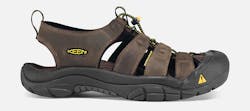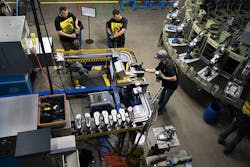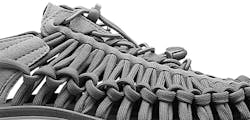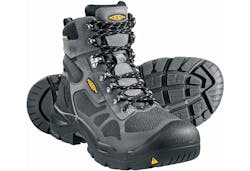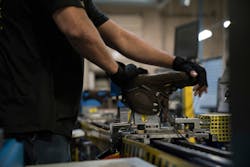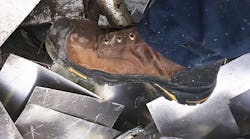It was already 102°, the air thick with smoke from some distant wildfire by the time I arrived at KEEN Inc.'s Portland boot factory last month. Perfectly absurd conditions for a factory tour.
But the absurdity felt right.
I was, after all, walking into a shoe factory in the United States. Moreover, at a time when around 99% of the shoes worn in this country are made in another and U.S. factory work is being steadily overtaken by robots and automation, I was entering an American footwear plant that is still dominated by real humans doing real work to create real products.
That's as absurd as it gets. But that's also kind of KEEN's thing.
KEEN, though a relative newcomer in the industrial footwear world, already has a long history of disruption and innovation. Its lines of strange, asymmetrical boots, shoes, and sandals have grown a cultish following based on the company's reputation for its unique, ultra-comfortable fit. As one of our product reviewers once commented, they are more comfortable than broken-in boots, right out of the box.
The company accomplishes this fit and maintains this reputation by doing things differently as a matter of principle and pride. Building a real-life American factory, they say, is just an extension of that.
"Innovation is ingrained in the culture here," explains Rory Fuerst Jr., director of innovation at KEEN. "As we see it, you have to be comfortable in the unknown, otherwise you'll never move forward."
This much was clear even before I got into the place. Located on Swan Island, just across the Willamette River from the company's downtown headquarters, KEEN's PM (Portland Manufacturing) factory was opened in 2010 just as we bottomed out at the end of the Great Recession—exactly when no one in their right mind would open a factory here.
And, going back even further, the company got its start 15 years ago with the bizarre, hard-toed Newport sandal that founder Rory Fuerst Sr. was told no one in their right mind would ever wear.
So absurdity is actually an integral part of the history here. It's where it all began.
And yet, in spite of that absurdity—or because of it—it's here and it's thriving. Though it's only one small part of KEEN's global manufacturing network, this factory makes a strong point about what the company really values.
"This place is all about change," says Chris Heffernan, general manager of the KEEN PM factory. "It's constantly innovating, constantly disrupting. We want to shake things up."
And, as far as I could tell, they are certainly doing that.
Standing inside, seeing it all unfold, it seems clear there's a story here—one I think goes far beyond just the boots on the line. By focusing on bold innovation above traditional tactics, the company has found a way not just to sell products and cultivate a growing army of customers, but to do so in a way that creates jobs in an impossible industry in an impossible setting.
The result is a mix that benefits the customer, the community, and the country in one fell swoop. And that's a lesson any company could do well to learn.
And it all starts, as Fuerst Jr. says, with innovation.
Time to Make the Boots
The first sign of this is right on the production line.
The line is set up in a U-shape, with teams prepping the uppers and outsoles of unassembled boots on one end, and a cluster of finishers polishing, inspecting, and boxing the final product on the other. Between them, at the bend, is a giant rotating injection molding machine that puts it all together.
This is a unique, sustainable system that eliminates the standard practice of gluing and stretching for a more permanent, and less wasteful, solution.
"The outsole and the upper are merged together and chemically bonded through molten hot PU," he explains. "That actually becomes the midsole."
The process is fascinating and quick and, perhaps even more interesting, almost completely unautomated. I counted just two robots on the floor, which were busy preparing the uppers just before injection. Otherwise, the boots are completely constructed by hand, all the way down to a knife-wielding flash remover cleaning up the excess PU.
This should all seem extremely outdated, I know. It should feel achingly old-fashioned and inefficient—an obvious attempt to create jobs in a setting that should be lights-out. But honestly, it seemed right.
KEEN Utility isn't a brand defined by mass production and low prices. It's defined by quality, fit, and utility.
"People are living and working and putting food on the table in these products," Fuerst Jr. says. "These people have to have great products, which means we have to provide great solutions."
Part of that is taking time to create quality boots, hands-on if necessary, to ensure every pair fits the needs of those customers.
It also means innovation, he says. Of constantly struggling to find new, better solutions, from the way the boots are made to the materials they use, to the very nature of shoe manufacturing.
And that is not a task they take lightly at KEEN.
Forging a New Path
When I met him in the lab, Fuerst Jr. was fresh off a long, exhausting mission to reinvent the very concept of shoes. The final product of this effort—the UNEEK—is a sandal made almost entirely out of meticulously knotted cord. It's a project, he says, that started at the local hardware store and eventually expanded to pull in robotics experts from Idaho to Japan to develop a system capable of creating this bizarre deconstruction of footwear, and swallowing six years of his life in the process.
"Every night, I would go to bed thinking, 'this isn't going to work,'" he recalls. "But it was such a fun process. By changing the cookbook, we weren't held captive to the same rules that most shoe developers were; we were creating a new path."
And the result is strong. Totally unique, totally weird, and—as I can personally attest after stomping around in a sample—almost unnaturally comfortable. They feel like no other shoe; they feel like nothing at all, in fact. Unnervingly comfortable.
The customers, Fuerst Jr. says, are already eating them up.
On the Utility side, Heffernan is just coming off his own innovation saga—a journey to take the weight, heat, and cow out of a traditional rugged work boot without losing the strength and durability they require.
"It took six months of going back and forth trying different materials," he recalls. "We needed a fabric that was breathable and light, but also super tough and super durable."
Finally, his team settled on a "Kevlar-esque" material, TUFF-TEX, which replaces the standard leather body of the uppers. The Concord boots, as they're now called, outperform leather and scratch tests and offer a base that even concrete can't seem to stick to, all the while feeling like a running shoe.
Together, these two projects really seem to capture what this whole story is about. As a standard practice, KEEN's team constantly redefines the market. It's normal and expected here.
"If I go into a meeting with a design the team has already seen somewhere else before, I get in a lot of trouble," Fuerst Jr. says. "There is constant pressure from the executive team to innovate. We need more than just a new KEEN shoe; we have to bring something special."
But this is absurd, right? It doesn't make sense to start fresh on every new design. It doesn't make sense to build wacky new designs in a country as expensive as the U.S. It doesn't make sense to do any of the things KEEN does.
But that is exactly where the whole story comes together.
The Case for American Manufacturing
In most companies—particularly, but not exclusively, in the footwear industry—there is a vast disconnect between R&D and manufacturing.
"A lot of companies are essentially just outsourcing design and concepts to third parties, making that product and getting it back," Fuerst Jr. says. "They just make a cool design and hope someone else can make it."
That's where KEEN has a distinct advantage.
The Portland factory houses the manufacturing side of the process and Fuerst Jr.'s design and innovation team. That means every new concept, every new prototype or mold configuration can be tested right on the manufacturing floor in real time.
"In manufacturing, there's nothing worse than coming in with something that everyone wants only to find that you can't make it or you can't make it for the money," Fuerst Jr. says. "By working through these things effectively live, we can see that coming and quickly address the issues when they come up."
As a result, he says, "we're doing things that honestly would have taken two or three weeks or more to work out in just days on-site in Portland."
So there's that element. U.S. production enables faster, more effective and far more profound levels of innovation. Makes sense. But Heffernan sees something possibly more dramatic—and more counter-intuitive: Shifting production to the U.S. makes financial sense.
"When companies outsource, they have this huge lead time for their products," he says. "That means it's going to take six or eight months. So you have to buy that much inventory to cover yourself in the interim."
Inventory turn, of course, is an obvious indicator of a business's health and success—one Heffernan notes Wall Street watches closely.
"People are starting to put the math together that all of this inventory is not financially sound in general because it's tying up a lot of cash," he says. "So the whole idea of building closer to market is really becoming attractive."
Reality Check
I'm painting a rosy picture here, I know. In this light, moving production back to the U.S. seems easy and smart, and obvious for any company to pursue. But, of course, that's not the full story.
The fact is, Heffernan admits, it's a struggle. It's hard work and filled with sacrifices. There have been downtimes and layoffs, there are cost limitations, and the factory is still far from hitting full capacity. As creative and exciting as it is, it's not immune from the reality of American manufacturing.
Currently, Heffernan says the Portland factory is churning over 20% of the KEEN Utility line. If needed, he said, he has plenty of current capacity and space to add new manufacturing lines in the facility. But they are taking it slow, measuring each step carefully so they can maintain this whole American manufacturing experiment long into the future.
"We've chosen where we can play and make that math work; it's definitely sustainable," he says. "Honestly, my biggest concern isn't if we can stay here, it's how we can grow."











